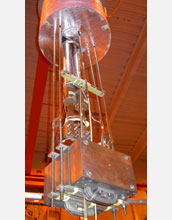Multimedia Gallery
New Superconducting Magnet
New Superconducting Magnet
This new magnet, developed by researchers at the National Superconducting Cyclotron Laboratory (NSCL) at Michigan State University, can withstand the high-radiation environment required for isotope research. Roughly the size of a shoebox, the magnet is shown here hanging beneath testing equipment at MIT's Plasma Science and Fusion Center. NSCL is a world-leading laboratory for rare isotope research and nuclear science education.
The National Science Foundation (grant PHY 01-10253) and the heavy-ion research facility Gesellschaft für Schwerionenforschung in Darmstadt, Germany, provided funding for the research. Brookhaven National Laboratory, the Plasma Science and Fusion Center at MIT, and Tyco Thermal Controls made important technical contributions. The magnet is described in the June issue of Institute of Electrical and Electronics Engineers Transactions on Applied Superconductivity.
For more information, see the MSU newsrelease "New Magnet May Help Pull Rare Isotope Science into the Future." (Date of Image: May 15, 2007)
Credit: Photo by Chen-yu Gung, MIT Plasma Science and Fusion Center
Images and other media in the National Science Foundation Multimedia Gallery are available for use in print and electronic material by NSF employees, members of the media, university staff, teachers and the general public. All media in the gallery are intended for personal, educational and nonprofit/non-commercial use only.
Images credited to the National Science Foundation, a federal agency, are in the public domain. The images were created by employees of the United States Government as part of their official duties or prepared by contractors as "works for hire" for NSF. You may freely use NSF-credited images and, at your discretion, credit NSF with a "Courtesy: National Science Foundation" notation.
Additional information about general usage can be found in Conditions.
Also Available:
Download the high-resolution JPG version of the image. (965 KB)
Use your mouse to right-click (Mac users may need to Ctrl-click) the link above and choose the option that will save the file or target to your computer.

